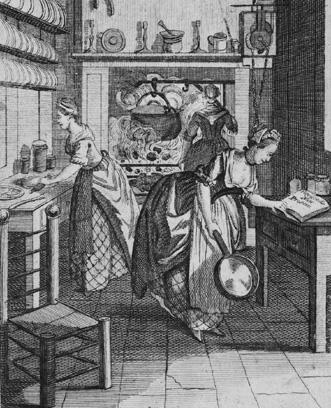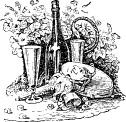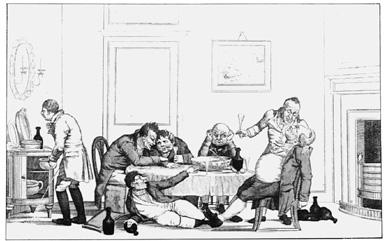If Walls Could Talk: An Intimate History of the Home (43 page)
Read If Walls Could Talk: An Intimate History of the Home Online
Authors: Lucy Worsley
Tags: #History, #Europe

Back in the mists of Norman time, England’s rulers spoke French and their downtrodden minions spoke English. The clash of cultures between invader and invaded is clear even in eleventh-century food bills, in which living animals are named in the Anglo-Saxon language of the servants who reared them: cow, sheep, swine, boar and deer. The same creatures appear on the table with the French names used by the Norman masters who ate them: beef, mutton, pork, bacon and venison.
The relationships between nations are expressed and statements of allegiance are made through food. This may be done
very simply with visual messages. At Henry VI’s Coronation Feast, the first course included dishes decorated with the symbols of his realms of England and France:
A red leach of sliced meats, eggs, fruits and spices, with lions carved therein in white
Custard royal with a leopard of gold sitting therein
Fritter like the sun, with a fleur-de-lis therein.
Attention always has to be paid to the symbolism of royal menus, and the unpopular Hanoverian kings of Britain further damaged their reputations by eating their native German sausages, Rhineland soup and cabbages. (‘Kraut’ and ‘Boche’, two derogatory terms for Germans, both come from cabbages which Germans are supposed to love.) Meanwhile, their Jacobite rivals made political capital by ostentatiously consuming even in exile dishes such as Devonshire pie and drinking good old British beer.
Despite Sturgeon’s complaints, the English did eat some sauces. An Elizabethan cookbook, for example, contains a ‘sauce for a roasted Rabbit’ said to have been favoured by Henry VIII containing parsley, butter, sugar, pepper and ‘a few crumbs of white bread’ to thicken it. But Charles II returned to England from his exile in 1660 with an unprecedented taste for saucy French dishes. For a time sauces came into high fashion: Hannah Woolley’s cookbook of 1677 contains seventy-two recipes for them, several described as ‘French’.
But these new French sauces failed to become part of the bedrock of British cooking. There persisted a lingering suspicion of ‘made’ dishes such as casseroles or ragouts. French dishes, as opposed to wholesome English roasts, signified moral degeneration in literature right up to 1813, when Jane Austen in
Pride and Prejudice
made the effete and rude Mr Hurst ignore the heroine from the moment ‘he found her prefer a plain dish to a ragout’.
In 1821,
The Cook’s Oracle
was among several publications
which attempted to persuade reluctant readers of the benefits of the available ‘Receipts for hashes, stews, and ragouts, &c., of these there are a great multitude … in the French kitchen they count upwards of 600, and are daily inventing new ones.’ The French had a very good reason to invent all these ragouts: in their hotter climate meat perished more quickly, and decay could be delayed or disguised by stewing. In England the more plentiful supply of succulent meat, combined with snobbery about stewing, meant that the roast remains a symbol of solid respectability right up to the present day.
Yet envy also played its part in this hatred of French sauces. The best and highest-paid cooks in Britain were always French, because sometimes, when entertaining to impress, nothing but a sophisticated and complicated sauce will do. Next best to a French chef was a French-trained one, and the Georgian William Verral fell into this category. He was shocked by the primitive kitchens he found in even a fairly well-to-do house in eighteenth-century Sussex: no pans beyond a stew pan and a frying pan, and that as ‘black as my hat’ with ‘a handle long enough to obstruct half the passage of the kitchen’. When he asked for a sieve, he was handed one which had been used for sanding the floor.
The formidable list of implements that Verral considered essential for proper French cooking included eight small stew pans, two very large ones, cake hoops, lemon squeezer, sugar cutters, toasting fork, a larkspit (literally for spitting larks), dripping pans, preserving pots and a ‘mustard bullet’. But above all, he needed several ‘sauce-pans’, pans literally for making sauces. The new kitchen ranges could only accommodate flat-bottomed pans, rather than round-bottomed pots, and in the late eighteenth century the saucepan came of age.
Georgian consumers needed little persuading that saucepans came in ‘sets’, and that one’s set should be complete. Stone and Company, advertising in
The Times
(1788), informed readers
that they had ‘greatly improved their sets of Tin Ware, which renders it the most wholesome and cheapest furniture in use, and preferable to others offered to the public’. Such adverts surely created a desire where none had existed before.

Saucepans were among a woman’s prized possessions: courtship gifts, everyday household utensils, personal-attack alarms or even weapons
These saucepans were usually copper with a tin lining. Copper could, over time, react with the acid in food to create a poison, so the tin was vital to keep the copper away from the food. If the tin lining became worn, it had to be replaced or the pan could
potentially poison. This was the role of the ‘tinker’ roving from door to kitchen door.
So the possession of a set of saucepans became the goal of many a Georgian housewife. Indeed, a man’s gift of a pan to an unmarried woman suggested that matrimony was imminent. In a marital dispute, a woman could lay claim to her saucepans with more chance of success than for any other items from the home except her clothes. She could clash them together to summon aid in cases of domestic violence – or even use them as weapons to strike back.
The idea that French sauces and cuisine should be admired, if not adopted for everyday meals, also found its way across the Atlantic to the New World. Hot summers, plentiful pasture and an outdoor-orientated culture meant that grilled meat and the barbecue became American standards by the 1950s.
But there too fine cooking would become inescapably French. Its greatest proselytiser was Julia Childs, who had an infectious passion for sauce. Her book of 1961,
Mastering the Art of French Cooking
, and her TV show,
The French Chef
, encouraged the ‘servantless American cook’ to abandon all concern for ‘budgets, waistlines, time schedules’ and ‘children’s meals’ in order to throw him- or herself into ‘producing something wonderful to eat’. Elizabeth Bennet would have been horrified.

44 – Were They All Drunk All the Time?
Would you believe it, though water is to be had in abundance in London, and of a fairly good quality, absolutely none is drunk? … In this country nothing but beer is drunk.
César de Saussure, 1720s
The alcohol consumption of people in the past often seems prodigious. For a start, everyone drank ale or beer in preference to water. The amounts consumed are impressive. The household of Humphrey Stafford, Duke of Buckingham, for example, consumed more than forty thousand gallons annually, while the monks of Fountains Abbey had a malthouse capable of producing sixty barrels of very strong beer every ten days.
In large households, the ‘butler’ was originally responsible for serving the beer at mealtimes. There are two theories about where his job title comes from: perhaps from the beer ‘butts’ which stored the ale, or perhaps from the French
botterlie
for beer cellar. Their proximity to alcohol made many butlers susceptible to ‘the butler’s complaint’: drinking. ‘All butlers grumble,’ complained one exasperated seventeenth-century employer, ‘they’re seldom dry, yet still they … drink.’ In the 1960s, the butler Peter Whiteley found himself fortunate enough to be sent
for drying out by his employer: ‘she paid for me to be treated by the highest doctor of his kind in the land’.
Apart from butlers, though, most people seemed to avoid dangerous levels of inebriation. The majority of their daily beer was very weak (‘smallbeer’) and provided a safer drinking choice than water. For working people, too, it also contained calories that were very necessary to their diet.
Many people are aware that the British climate has waxed and waned, and during the ‘warm centuries’ – the tenth and eleventh – vineyards flourished in England. In 1289, the Bishop of Hereford was still managing to produce 882 gallons of white wine on his estates. But most English grapes were used to make verjuice (a fermented sour juice), and the best wine was imported.
Strong red Gascon wine was the long-time favourite of British drinkers, except during the periods when wars with the French or disputes with the Dutch merchants who transported it disrupted supplies. In the seventeenth century, sweet wines from Portugal and the Canary Islands ousted their French and German predecessors from the top of the wine importers’ lists. The volumes consumed are impressive: each member of the garrison of Dover Castle, for example, was given a quart of wine a day in the fourteenth century.
But just like beer, wine wasn’t as strong as it is today. Neither were the sharp young wines or ‘verjuices’ of England as horrid as they sound: they were drunk with sugar or spices added. No one drank mature wine because the casks it was stored in failed to keep out air and it went very bitter very quickly. Only when bottled wine first began to appear in the later Tudor period did maturity and its resultant flavour become appreciated.
Spirits became popular in Ireland before England. They began to seduce Tudor drinkers in the sixteenth century, performing their marvellous work of taking ‘away sadness’ and of making men ‘witty’. Spirits were also known as ‘cordial waters’, and
were thought to stimulate the heart; ‘aqua vitae’ or ‘burning waters’ were taken like medicines. But their advertised powers of keeping the plague away were seen sadly to fail during the epidemics of 1593, despite their being widely consumed. The distillers lost much credit as a result.
While alcohol was ubiquitous, and while beer formed an important part of nutrition, that’s not to say it wasn’t abused. It’s been argued that many medieval battles took place between drunken combatants: both to raise their courage and to dull the pain of wounds. Less appropriate was drunkenness at home. ‘If any man do perceive that he is drunk,’ wrote a Tudor doctor, ‘let him take a vomit with water and oil, or with a feather, or a rosemary branch, or else with his finger, or else let him go to his bed to sleep.’ In 1552, the first Licensing Act was passed because of the ‘intolerable hurts and troubles’ caused by the drinkers in alehouses. From then on, landlords had to acquire a licence for their premises from the local Justice of the Peace. Constant complaints about drunkenness followed: in 1576, the poet George Gascoigne described inebriation as ‘a monstrous plant, lately crept into the pleasant orchards of England’.
But drinking remained central to social interaction in Britain, and its elites especially liked to overindulge during all-male gatherings. His cistern and wine cooler of silver were among a seventeenth-century nobleman’s most prized possessions. He and his friends would be presented with a glass of wine by their servants whenever they called for it throughout a dinner. The servant would hand a full glass to the drinker, who would drain rather than sip it and then hand it back for rinsing and refilling. The ceremonial departure of the ladies from the table to the drawing room marked the start of serious all-male drinking, something that the abstinent John Evelyn described as the ‘drink-ordeal’. Whenever he dined at someone else’s house, he found it necessary to steel his liver for trial by alcohol, which took place ‘whether for the want of better to employ the time,
or affection to the drink, I know not’. There were some aristocrats, he warned, ‘whom one could not safely visit after dinner’. Ladies, though, were not expected to indulge in such antics: the eighteenth-century Queen Caroline would bawl out a drunken gentleman, railing ‘at him before all the Court upon getting drunk in her company’.

